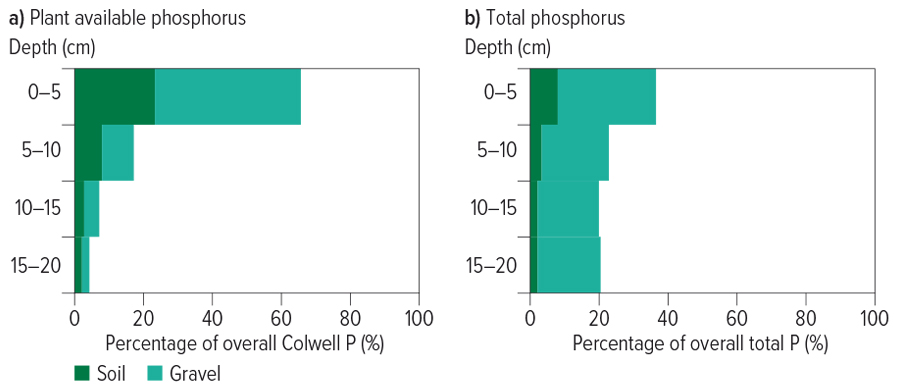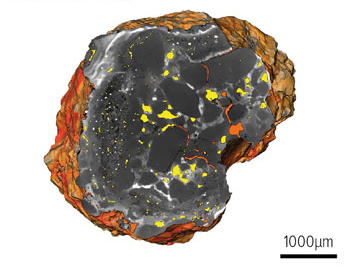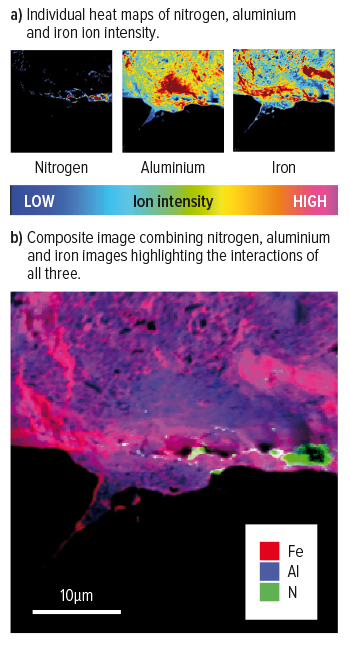Key Message
- Cutting-edge tools and adapted standard soil analysis protocols are being used to learn more about nutrient use efficiency of ironstone gravel soils to better inform their management.
Ironstone gravel soils are common across Australia’s southern cropping regions. Yet, while they may receive sufficient rainfall, their nutrient use efficiency is typically low.
However, detailed research is underway at SoilsWest at the University of Western Australia (UWA), with GRDC investment, to examine these soils’ properties. This will provide new base knowledge of the interactions between the landscape, chemical and physical properties of ironstone gravel soils, and insights into their role in soil water and nutrient retention. Ultimately the findings will support improved nutrient management decisions for cropping.
Figure 1: An iron-dominated gravel with aluminium as a secondary element in loamy-sand soil has the majority of phosphorus bound to the gravel fraction: (a) plant-available phosphorus, and (b) total phosphorus.

Source: Francesca Brailsford, UWA
Analysis
Conventional soil analysis involves sieving to two millimetres, which excludes gravel, therefore the gravel composition and its impacts on nutrient (phosphorus, nitrogen) and water movement through soils are largely unknown.
To enhance our understanding of nutrient use efficiency of gravel soils, gravels are being processed using adapted protocols for standard soil analyses, combined with advanced research.
This includes ‘mineralogical powder diffraction analysis’ using the Australian Synchrotron in Melbourne, and a range of imaging and microanalysis techniques at the Centre for Microscopy, Characterisation and Analysis (CMCA) at UWA.
Chemical analyses of gravel soils from a range of sites in WA, South Australia and Victoria have highlighted key differences between different gravel types (iron, aluminium or silica dominated). Increasing gravel iron content is associated with higher phosphorus content, while for increasing silica content, lower phosphorus.
Figure 2: Micro-CT tomography scan of an internal silica-dominated gravel structure. Orange pores are surface-connected, while yellow pores are internal pores with no connection to the surface.

Source: Jeremy Shaw, CMCA
Mineralogical data from the powder diffraction beamline at the Australian Synchrotron has shown that haematite – a common iron oxide – content, in particular, is associated with higher gravel phosphorus content.
Further elemental analysis of a gravel soil profile has revealed that even though there was no change in gravel composition with depth, gravel appears to restrict phosphorus movement down through the soil profile.
In a paddock historically used for cropping, more than 90 per cent of phosphorus inputs remained in the top 20 centimetres of the soil.
Despite gravels being less than one per cent of the total below-ground surface area available for nutrient binding, 60 per cent Colwell phosphorus (that is plant-available phosphorus) and 84 per cent total phosphorus was found to be associated with gravels (Figure 1a and b).
This finding confirms that gravels have the potential to bind phosphorus and other nutrients within the soil.
New techniques
Figure 3: Nanoscale secondary ion mass spectrometry (nanoSIMS) output from a 40 x 40 µm section of gravel cross-section edge: (a) individual heat maps of nitrogen, aluminium and iron ion intensity, and (b) composite image combining nitrogen, aluminium and iron images, highlighting the interactions of all three.

Source: Jeremy Bougoure, CMCA
To understand these nutrient dynamics further, the UWA team is developing methods to quantify the capacity for predicting nutrient binding of both nitrogen and phosphorus to the gravels.
Three-dimensional X-ray scans of gravel structure using micro-computed tomography have demonstrated that gravel surface area is generally predictable from gravel mass or diameter, allowing the prediction of the surface area available for nutrient binding.
However, the gravel scans have also highlighted the presence of pore networks within the gravels, some of which are connected to the surface, providing opportunities for water, nutrients and microbes to enter (Figure 2).
A method to quantify the additional internal surface area available for binding is being developed at CMCA.
The extent of movement of nitrogen and phosphorus into the gravel can be measured using stable isotope tracers that are imaged using nanoscale secondary ion mass spectrometry (nanoSIMS, Figure 3).
This information provides new insights into the extent of microbial and plant availability of the nutrients inside the gravel nodules of differing chemical compositions.
In conjunction with nanoSIMS, experiments to quantify bulk gravel nutrient and water holding capacities are currently being run on a range of gravel types.
A combination of radioisotope and nutrient tracer techniques quantifying nitrogen and phosphorus binding capacities under a range of conditions are being jointly conducted at UWA and Bangor University, Wales.
Insights for growers
Researchers are combining the gravel structural relationships from micro-CT tomography with nitrogen and phosphorus binding data in order to determine nitrogen/phosphorus binding capacities for different gravel types (Figure 4).
With this information, measuring nitrogen and phosphorus concentrations within a paddock should indicate whether a gravel soil is near to its nitrogen/phosphorus binding capacity and thus whether future nutrient additions will be bound by gravels or remain available to plants. This will help inform more-targeted management of different gravel soils in the future.
More information: Dr Francesca Brailsford, fran.brailsford@uwa.edu.au, 0434 021 676; Professor Daniel Murphy, daniel.murphy@uwa.edu.au

























































